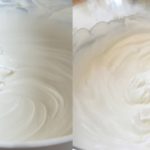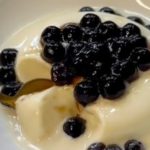Ingredients for Baking
While traditional flan relies solely on eggs, you can add whipping cream while whisking the eggs.
Whipping cream adds firmness, smoothness, and elasticity to the flan, and its richness enhances the flavor significantly.
If you’re not a fan of rich desserts, feel free to reduce the amount of whipping cream and compensate with milk, ensuring that the total liquid quantity in the recipe remains unchanged.

Notes on Whisking Eggs
Vigorously whisking the eggs incorporates more air and speeds up the process. However, this can lead to a flan that is more prone to cracking after baking.
It is advisable to whisk gently, just enough to break down the eggs without creating foam. Then, use a strainer to filter the egg-milk mixture, removing any air bubbles and ensuring a smoother texture.
Additionally, when whisking, maintain a consistent direction to avoid disrupting the egg structure. Changing directions can cause the eggs to lose their optimal smoothness.

Baking Flan – The Bain-Marie Method
Flan can be baked using the bain-marie method in an oven or steamed.
When using the bain-marie method, pay attention to the temperature and timing:
Temperature: Set the oven to 100°C, and adjust the temperature up or down by 10-20 degrees Celsius depending on your oven’s temperature and the size of your baking dish.
Timing: Typically, flan is baked for 50-60 minutes, depending on its size. If you’re making a larger flan and the temperature is below 100°C, consider increasing the baking time by 10-20 minutes to ensure it cooks through.

Steaming Flan
+ Bring the water to a boil before placing the flan in the steamer.
+ Steam the flan over low heat for 15-30 minutes, depending on its size. Use a toothpick to check for doneness; if it comes out dry, the flan is ready.
+ Do not cover the flan while steaming to avoid condensation, as water droplets can cause the surface of the flan to crack.

With these tips, you can now create a delicious, smooth, and crack-free flan at home.
Stay tuned to our Food section for more mouthwatering recipes for your family and friends.
What is Whipped Cream? Understanding the Difference Between Whipped Cream and Whipping Cream.
“When it comes to baking, we often use a variety of fresh creams, one of which is whipped cream. But what exactly is whipped cream, and how is it different from whipping cream? Let’s delve into this creamy conundrum and explore the differences between these two delightful toppings. Get ready to indulge in a sweet exploration of the world of whipped cream!”





































